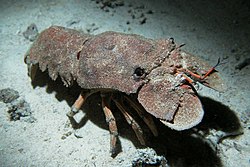Portal:Crustaceans Source: en.wikipedia.org/wiki/Portal:Crustaceans
The Crustaceans Portal Crustaceans (from Latin meaning: "those with shells" or "crusted ones") are invertebrate animals that constitute one group of arthropods that are traditionally a part of the subphylum Crustacea (/krəˈsteɪʃə/), a large, diverse group of mainly aquatic arthropods including decapods (shrimps, prawns, crabs, lobsters and crayfish), seed shrimp, branchiopods, fish lice, krill, remipedes, isopods, barnacles, copepods, opossum shrimps, amphipods and mantis shrimp. The crustacean group can be treated as a subphylum under the clade Mandibulata. It is now well accepted that the hexapods (insects and entognathans) emerged deep in the crustacean group, with the completed pan-group referred to as Pancrustacea. The three classes Cephalocarida, Branchiopoda and Remipedia are more closely related to the hexapods than they are to any of the other crustaceans (oligostracans and multicrustaceans). The 67,000 described species range in size from Stygotantulus stocki at 0.1 mm (0.004 in), to the Japanese spider crab with a leg span of up to 3.8 m (12.5 ft) and a mass of 20 kg (44 lb). Like other arthropods, crustaceans have an exoskeleton, which they moult to grow. They are distinguished from other groups of arthropods, such as insects, myriapods and chelicerates, by the possession of biramous (two-parted) limbs, and by their larval forms, such as the nauplius stage of branchiopods and copepods. Most crustaceans are free-living aquatic animals, but some are terrestrial (e.g. woodlice, sandhoppers), some are parasitic (e.g. Rhizocephala, fish lice, tongue worms) and some are sessile (e.g. barnacles). The group has an extensive fossil record, reaching back to the Cambrian. More than 7.9 million tons of crustaceans per year are harvested by fishery or farming for human consumption, consisting mostly of shrimp and prawns. Krill and copepods are not as widely fished, but may be the animals with the greatest biomass on the planet, and form a vital part of the food chain. The scientific study of crustaceans is known as carcinology (alternatively, malacostracology, crustaceology or crustalogy), and a scientist who works in carcinology is a carcinologist. (Full article...) Selected article
Scyllarides latus, the Mediterranean slipper lobster, is a species of slipper lobster found in the Mediterranean Sea and in the eastern Atlantic Ocean. It is edible and highly regarded as food, but is now rare over much of its range due to overfishing. Adults may grow to 1 foot (30 cm) long, are camouflaged, and have no claws. They are nocturnal, emerging from caves and other shelters during the night to feed on molluscs. As well as being eaten by humans, S. latus is also preyed upon by a variety of bony fish. Its closest relative is S. herklotsii, which occurs off the Atlantic coast of West Africa; other species of Scyllarides occur in the western Atlantic Ocean and the Indo-Pacific. The larvae and young animals are largely unknown.
Did you know?
Selected biography
Henri Milne-Edwards (Bruges, October 23, 1800 – Paris, July 29, 1885) was an eminent French zoologist. He was the 27th child of an English father (Wiliam Edwards) and a French mother (Elisabeth Vaux). Henri was born in Bruges, now in Belgium, but then part of the French Republic, and he spent most of his life in France. Henri was brought up in Paris by his older brother William Edwards, a physiologist. After studying medicine in Paris, his passion for natural history prevailed, and he studied the "lower forms" of animal life. He studied under Georges Cuvier and befriended Jean Victoire Audouin. In 1832, Milne-Edwards became professor of hygiene and natural history at the Collège Central des Arts et Manufactures. In 1841, after the death of Audouin, Milne-Edwards succeeded him at the chair of entomology at the Muséum National d'Histoire Naturelle. In 1862, he succeeded Isidore Geoffroy Saint-Hilaire in the long-vacant chair of zoology.
Much of his original work was published in the Annales des sciences naturelles, which he edited from 1834. His Histoire naturelle des Crustacés (1837–1841), long remained a standard work; other works include Histoire naturelle des coralliaires (1858–1860), Leçons sur la physiologie et l'anatomie comparée de l'homme et des animaux (1857–1881), and a work on the elements of zoology, originally published in 1834, but subsequently remodelled, which enjoyed an enormous circulation. Selected image Liocarcinus marmoreus, the marbled swimming crab, is a species of crab found in the northern Atlantic Ocean and North Sea. General imagesThe following are images from various crustacean-related articles on Wikipedia.
Crustacean lists
SubcategoriesRelated portalsWikiProjectsAssociated WikimediaThe following Wikimedia Foundation sister projects provide more on this subject:
Discover Wikipedia using portals
|





















































